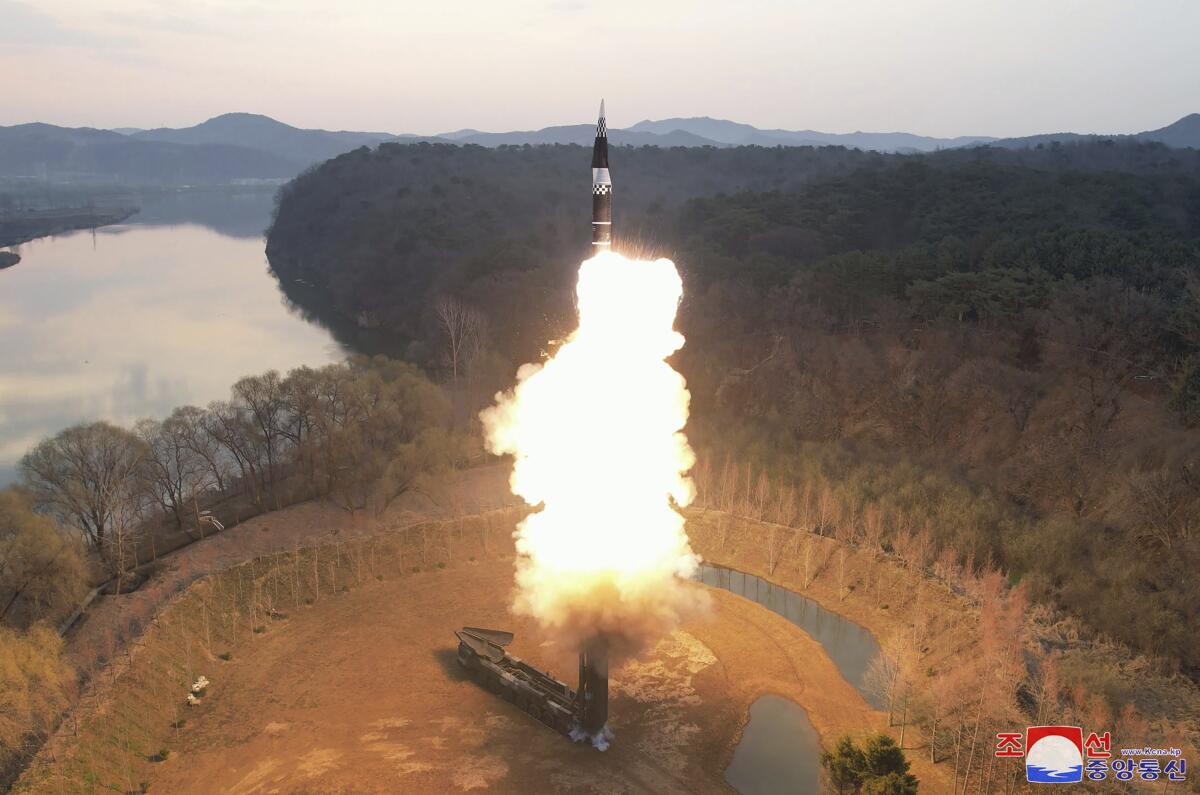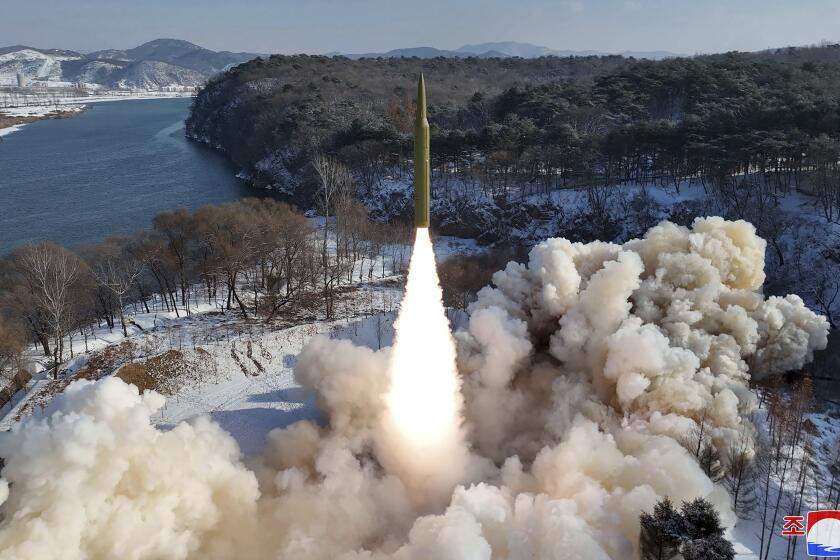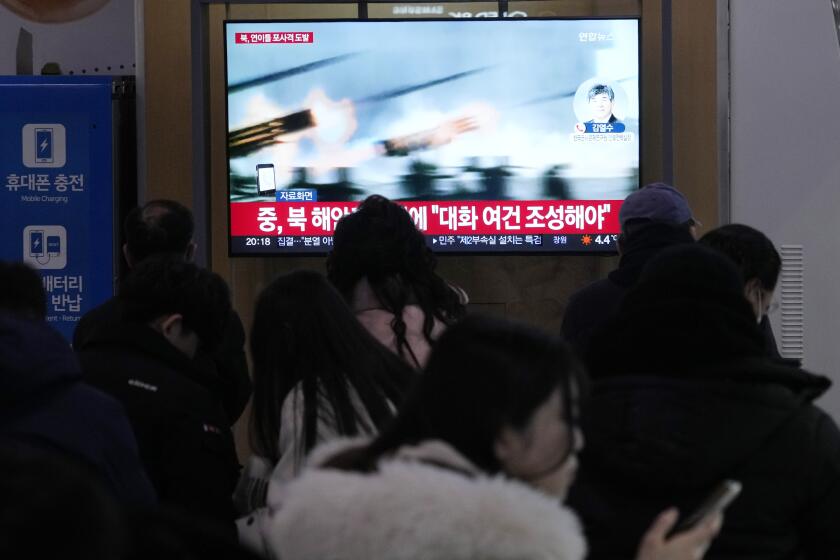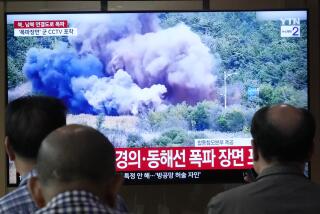N. Korea says it tested a new hypersonic intermediate-range missile that is easier to hide

- Share via
SEOUL, South Korea — North Korea said Wednesday it had tested a new hypersonic intermediate-range missile powered with solid propellants, extending a run of weapons tests that’s deepening a nuclear standoff with neighbors and the United States.
With the supposed success of the demonstration, North Korean leader Kim Jong Un declared his country had acquired the ability to build solid-fuel, nuclear-capable missiles of all ranges as he pursues an arsenal that can credibly threaten rivals in Asia and the United States.
But the South Korean military said the North is exaggerating the success of the test and its overall missile prowess.
The report by North Korean state media came a day after the South Korean and Japanese militaries detected a missile launched from near the North’s capital toward its eastern sea.
North Korea says it has flight-tested a new intermediate-range missile tipped with a hypersonic warhead as it further builds up its arsenal.
State media said the test was supervised by Kim, who described the Hwasong-16B missile as a key piece of his nuclear deterrent he vowed to further build up to counter his “enemies,” a reference to the United States, South Korea and Japan.
In recent years, North Korea has been developing more missiles with built-in solid propellants. Such weapons are easier to move and hide, and can be launched quicker than liquid-propellant missiles, which need to be fueled before launch and cannot stay fueled for long periods of time.
North Korea tested a solid-fuel intercontinental ballistic missile for the first time last year, adding to its arsenal of long-range weapons targeting the U.S. mainland. The country also has an extensive lineup of short-range and mid-range solid-fuel missiles that can be fired from land vehicles, ships and submarines and are potentially capable of hitting targets throughout South Korea and Japan. In recent months, the North demonstrated some of these missiles in drills it described as simulated nuclear strikes.
Since 2021, it’s also been testing hypersonic weapons designed to fly at more than five times the speed of sound. If perfected, such systems could potentially pose a challenge to regional missile defense systems because of their speed and maneuverability. However, it’s unclear whether these missiles are consistently flying at the speeds the North claims.
South Korea says North Korea has conducted a new round of artillery firing drills near the rivals’ disputed sea boundary.
North Korean official media KCNA claimed that during the Tuesday test, the missile’s hypersonic glide warhead reached a peak altitude of 62 miles and flew about 621 miles after separating from the launch rocket, and performed various maneuvers before landing in waters between the Korean Peninsula and Japan.
South Korea’s Joint Chiefs of Staff on Wednesday maintained its assessment that the missile flew about 372 miles and accused North Korea of exaggerating the missile’s flight performance, although acknowledging that the North’s technologies were improving. The previous day, Japan reported a similar flight distance, although its Defense Ministry reported a maximum height close to that claimed by the North.
The Joint Chiefs of Staff said it remains unclear whether the North has perfected the technologies to ensure that the warheads of its hypersonic solid-fuel missiles and intercontinental ballistic missiles survive the harsh conditions of atmospheric re-entry.
North Korean leader Kim Jong Un has called for rewriting the country’s constitution to eliminate the idea of shared statehood with the South.
“Hypersonic missiles are weapons systems that are still being developed by advanced nations [the United States, China and Russia etc.] and they require highly difficult technologies,” the Joint Chiefs of Staff said in a text message to reporters. “It’s difficult to predict when they will be deployed operationally, but it’s expected to take a considerable amount of time.”
The North also tested a purported hypersonic intermediate-range ballistic missile in January, years after it flight-tested liquid-fuel IRBMs. Experts say such weapons if perfected are potentially capable of reaching remote U.S. targets in the Pacific.
“North Korea’s development of hypersonic IRBMs targets Guam, which hosts U.S. military bases, and even Alaska,” said Chang Young-keun, a missile expert at South Korea’s Research Institute for National Strategy.
Kim Dong-yub, a professor at the University of North Korean Studies in Seoul, said the missile tested on Tuesday was likely different from the system tested in January, which state media didn’t name but was likely the Hwasong-16A.
The North Korean Foreign Ministry highlighted Putin’s intention to visit after meetings with the Russian president and foreign minister in Moscow last week.
North Korea in previous tests have unveiled two different types of hypersonic vehicles — a conical one and a wedge-shaped one. State media images show that the January launch involved a conical warhead while the wedge-shaped design was used for Tuesday’s launch.
Tensions in the region have risen since 2022 as Kim used Russia’s invasion of Ukraine as a distraction to accelerate his testing of missiles and other weapons. The United States and South Korea have responded by expanding their combined training and trilateral drills involving Japan and sharpening their deterrence strategies built around strategic U.S. assets.
Hours after the launch, Seoul’s Defense Ministry announced that South Korea, the United States and Japan conducted a combined aerial exercise above waters near South Korea’s Jeju island that involved at least one nuclear-capable U.S. B-52 bomber.
Kim writes for the Associated Press. AP writer Hyung-jin Kim contributed to this report.
More to Read
Sign up for Essential California
The most important California stories and recommendations in your inbox every morning.
You may occasionally receive promotional content from the Los Angeles Times.

















